Datum
2020-11-29Metadata
Zur Langanzeige
Aufsatz

Optimization of cassava dried noodle using hydrocolloid and protein isolates: a tropical noodle
Zusammenfassung
Cassava flour has the potential to be used as a substituent of flour in making dry noodles. This study aims to obtain the optimum formulation of flour, hydrocolloid content and protein isolate content. Formula optimization of cassava noodle has been done by using two types of cassava flour: native and pre-gelatinization, adding additional food additives such as hydrocolloid (xanthan gum and konjac glucomannan) and pea protein isolate. The design of the formulation and optimization is done by D-optimal combined design method through Design Expert 7.0®. There are 31 different formulas for a test response that includes hardness, tensile strength, and cooking loss. Considering the three responses, the recommended optimum noodles formulation is based on pre-gelatinized cassava flour, 2% xanthan gum, 0% konjac glucomannan, and 4% protein isolate. The selected formula has water content, ash content, protein content, fat content, and carbohydrate content of 5.92%; 0.793%; 4.29%; 1,342%; and 87.025%. The level of consumer acceptance of texture, aroma, color, and overall parameters has a range of 3 (regular) to 4 (like). The optimum formula may be used for product development of cassava dried noodles.
Zitierform
In: Future of Food: Journal on Food, Agriculture & Society Vol. 8 / No. 4 (2020-11-29) EISSN 2197-411XSammlung(en)
Vol 08, No 4 (2020) (Future of Food: Journal on Food, Agriculture & Society // The Future of Food Journal: Journal on Food, Agriculture & Society)Zitieren
@article{doi:10.17170/kobra-202010131943,
author={Parassih, Elfa Karin and Purwani, Endang Yuli and El Kiyat, Warsono},
title={Optimization of cassava dried noodle using hydrocolloid and protein isolates: a tropical noodle},
journal={Future of Food: Journal on Food, Agriculture & Society},
year={2020}
}
0500 Oax
0501 Text $btxt$2rdacontent
0502 Computermedien $bc$2rdacarrier
1100 2020$n2020
1500 1/eng
2050 ##0##http://hdl.handle.net/123456789/12389
3000 Parassih, Elfa Karin
3010 Purwani, Endang Yuli
3010 El Kiyat, Warsono
4000 Optimization of cassava dried noodle using hydrocolloid and protein isolates: a tropical noodle / Parassih, Elfa Karin
4030
4060 Online-Ressource
4085 ##0##=u http://nbn-resolving.de/http://hdl.handle.net/123456789/12389=x R
4204 \$dAufsatz
4170
5550 {{Maniok}}
5550 {{Mehl}}
5550 {{Hydrokolloid}}
5550 {{Teigware}}
7136 ##0##http://hdl.handle.net/123456789/12389
<resource xsi:schemaLocation="http://datacite.org/schema/kernel-2.2 http://schema.datacite.org/meta/kernel-2.2/metadata.xsd"> 2021-01-06T14:56:38Z 2021-01-06T14:56:38Z 2020-11-29 doi:10.17170/kobra-202010131943 http://hdl.handle.net/123456789/12389 eng Urheberrechtlich geschützt https://rightsstatements.org/page/InC/1.0/ cooking loss hardness response surface method tensile strength cassava dried noodle hydrocolloid optimization protein isolate 580 640 Optimization of cassava dried noodle using hydrocolloid and protein isolates: a tropical noodle Aufsatz Cassava flour has the potential to be used as a substituent of flour in making dry noodles. This study aims to obtain the optimum formulation of flour, hydrocolloid content and protein isolate content. Formula optimization of cassava noodle has been done by using two types of cassava flour: native and pre-gelatinization, adding additional food additives such as hydrocolloid (xanthan gum and konjac glucomannan) and pea protein isolate. The design of the formulation and optimization is done by D-optimal combined design method through Design Expert 7.0®. There are 31 different formulas for a test response that includes hardness, tensile strength, and cooking loss. Considering the three responses, the recommended optimum noodles formulation is based on pre-gelatinized cassava flour, 2% xanthan gum, 0% konjac glucomannan, and 4% protein isolate. The selected formula has water content, ash content, protein content, fat content, and carbohydrate content of 5.92%; 0.793%; 4.29%; 1,342%; and 87.025%. The level of consumer acceptance of texture, aroma, color, and overall parameters has a range of 3 (regular) to 4 (like). The optimum formula may be used for product development of cassava dried noodles. open access Parassih, Elfa Karin Purwani, Endang Yuli El Kiyat, Warsono Maniok Mehl Hydrokolloid Teigware publishedVersion EISSN 2197-411X No. 4 Future of Food: Journal on Food, Agriculture & Society Vol. 8 false </resource>
Die folgenden Lizenzbestimmungen sind mit dieser Ressource verbunden:
Urheberrechtlich geschützt

